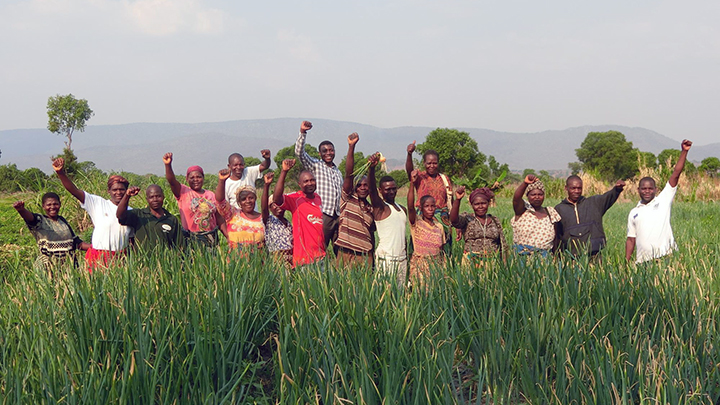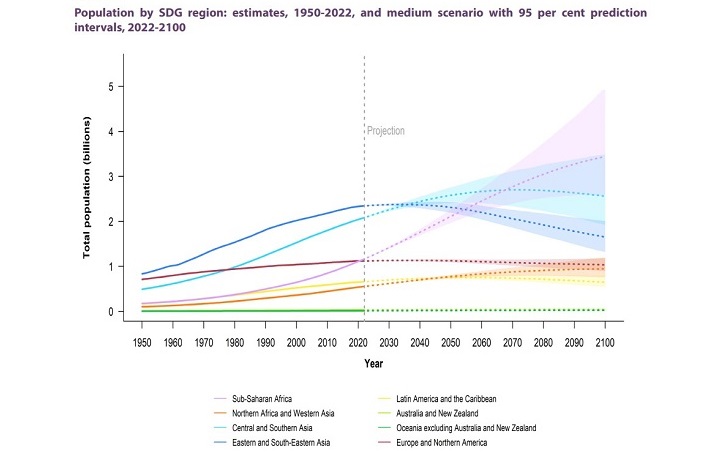Blog “Food Security and Agricultural Development in Light of Africa’s Development” (2): Employment Creation for Younger Generations
2025.03.04
Researchers at the JICA Ogata Sadako Research Institute for Peace and Development (JICA Ogata Research Institute) have wide-ranging experience and diverse backgrounds, and they are forging partnerships with varied stakeholders and partners. This series of blog posts shares the knowledge and perspectives that they have acquired through their research activities. This blog post was written by Amameishi Shinjiro, Executive Senior Research Fellow, who is working on research on agricultural development in Africa.

(Photo: JICA)
Author: Amameishi Shinjiro, Executive Senior Research Fellow, JICA Ogata Research Institute
In recent years, the word “youth” is frequently used in the international community. To work on diverse topics that are relevant to our future, such as the SDGs, climate change and environment, and digitalization, the power of young people is in need: how there were many youth-led sessions during the Summit of the Future, held at the United Nations headquarters in September 2024, is still fresh in our memory. As the outcome documents of this summit, the Pact for the Future, and its annex, the Declaration on Future Generations, were adopted. While the definition of “future generations” in these documents includes those who have not been born yet, anticipation of youth empowerment and youth business participation was clearly set forward. The declaration also covers food and agriculture. The need for inclusive economic growth, sustainable development, food security and ending poverty in order to build a foundation for future generations is stated, with African countries mentioned as the most vulnerable in the world. Active youth participation is necessary for food security and agricultural development in Africa.
In Africa, due to the high population growth rate, “youth bulge,” which is the large increase in the percentage of children and young adults in the population, is ongoing. Three-fourths of those in poverty in Africa work in agriculture (World Bank 2020) and most youths, whose population is rapidly increasing, live in rural areas. If appropriate policies relevant to the increase in young workforce can be formulated and implemented, this “population bonus” will bring huge economic benefits. However, it will become a burden for economic development if efforts are not steered toward spot-on policies. Cautiousness and a sense of urgency have been expressed toward Africa’s possible struggle over the next several decades to sufficiently absorb young jobseekers (Mueller et al. 2019). In Sub-Saharan Africa (SSA), the current population of 1.152 billion (2022) is predicted to almost double to 2.094 billion in 2050 and continue to grow. By 2100, SSA is expected to become the most greatly populated region in the world (Fig. 1). Young workers mainly live in rural areas and while a large number of them are entering the labor market, whether the agricultural sector — a sector which they are familiar with — can actively take them in, thereby leading to healthy economic development, is going to be put to the test.

Fig. 1: Future population estimates by region
Source: UN Department of Economic and Social Affairs Population Division (2022)
Unfortunately, sufficient progress has not been seen so far in employment creation in the agricultural sector. Although the Comprehensive Africa Agriculture Development Programme (CAADP), which is led by the African Union (AU), sets forth efforts to facilitate the youth employment in agriculture, the latest results of its biennial review (2024) show that the score that indicates progress level*1 is 3.62 out of 10 (a score of 9.00 is seen as the benchmark for being “on track”), and there is a significant delay in progress (AU and AUDA-NEPAD 2024). Sufficient efforts for youth participation in the agricultural sector have not been made in SSA countries.
Investigation and analysis of 13 countries in the SSA region by Mueller et al. (2019) have shown that their policies fail to meet the needs of young jobseekers. For example, the majority of young people in rural areas are informally employed and not protected by labor law systems, and their interests and needs are not considered enough. Based on the results of an analysis of 30 publications on youth participation in agriculture in Africa, Geza et al. (2021) pointed out the following: existing agricultural intervention measures do not respond to the dynamism of young people as they focus on production and do not appropriately deal with structural issues, such as insufficient youth participation in value chains; and therefore, policies that promote efforts on value chains and food systems*2 and expand opportunities for young people need to be introduced.
At the national level, in Kenya, as policies and investments from the government have not generated the expected level of inflow of young workforce to the agricultural sector, there is a need for policies and services that are based on further intervention strategies to draw in youths who are agriculture-oriented (Musundi et al. 2021). Moreover, as young people who want to become full-time farmers are rare, a comprehensive approach to agricultural policies that allow for combined livelihoods in which the primary livelihood source is other than agricultural production (for example, capital acquired through agriculture is used for business investment, or vice versa) is necessary (Larue et al. 2021). In Nigeria, factors that lessen the involvement of young people in agricultural production in rural areas can be categorized into three types: economic (low credit limit, low profit rate, as well as insufficient agriculture insurance, initial capital and farming equipment), which is the largest of the three; social (how agriculture is perceived by the general public and the influence of parents who are trying to move away from agriculture); and environmental (lack of land, continued struggle with yield and soil degradation) (Akpan 2010).
For young people, the self-sufficient nature of agriculture is less appealing while its economic side is highly attractive. Therefore, the following is required: removal or mitigation of restrictions including social and environmental factors, along with the prioritization of economic factors to transform agriculture into an industry that generates sufficient profits; and in addition to the creation of more employment opportunities in industries closely related to agriculture to allow for the generation of sufficient income, stimulation of economic activities in rural areas for area development and further employment creation. Together with eighteen other development partners, JICA participates in the Coalition for African Rice Development (CARD), an initiative that aims to double rice production in Africa. CARD also works on the reduction of post-harvest loss and quality improvement, strengthening marketing and the development of a value chain that improves distribution through collaboration with the private sector. These directly contribute to employment creation and income increase for youths in rural areas. Experience accumulated through efforts in Asia has shown that poverty reduction is faster when more better-paying jobs are created in smallholder agriculture and agribusiness. (WB 2020). Luc Christiaensen and Miet Maertens (2022) pointed out that future policies need to work on how to encourage investments in agricultural and food systems, generate demand for non-agricultural products and services for which rural households have competitiveness, and create more high-quality jobs in rural areas.
In 2017, Thedore Ahlers and Harinder Kohli of Centennial Group International, together with the JICA Ogata Research Institute, published “Africa Reset: A New Way Forward ,” a book which shows the outcomes of research work on how development in Africa should progress in the future. This book emphasizes that the creation of a sufficient number of meaningful jobs to accommodate the expected youth bulge is the single most important challenge facing Africa. Job creation for youths is also a means to meet the fast-rising aspirations of Africans and to put the continent on a faster track to achieve convergence with the rest of the world. The book also points out that one of Africa’s strengths is the increase in the number of young workers and therefore job creation in the agricultural sector, where many people in poverty are engaged in, is crucial for long-term economic growth in Africa. It further states that “the political will to adopt and implement bold policy reforms is decisive in determining a country’s success. It is also the scarcest commodity in the region.” Indeed, it is up to what extent African countries and their development partners can address this challenge.
*1 In the reviews by CAADP, progress is evaluated on a scale of 1 to 10 for each element. The benchmark score for being “on track” depends on each element and is revised per review.
*2 Food systems can be defined as systems that encompass all actors as well as their interlinked value-adding activities involved in the production, aggregation, processing, consumption and disposal of food products that originate from agriculture, food processing, distribution, consumption and disposal. To enable transformation into sustainable food systems, efforts from three perspectives, economic, social and environmental, are necessary (FAO, 2018).
African Union (AU) and African Union Development Agency (AUDA-NEPAD). 2024. 4th CAADP Biennial Review Report 2015-2023.
Akpan, Sunday Brownson. 2010. “Encouraging Youth’s Involvement in Agricultural Production and Processing” IFPRI Nigeria Strategy Support Program. Policy Note No. 2.
Ahlers, Theodore, and Harinder S. Kohli. 2017. Africa reset: a new way forward. Tokyo: Centennial Group International, Japan International Cooperation Agency (JICA), and Oxford University Press.
Christiaensen, Luc and Miet Maertens. 2022. “Rural Employment in Africa: Trends and Challenges” Annual Reviews of Rural Economics. 2022. 14:267–89
Food and Agriculture Organization (FAO). 2018. Sustainable Food Systems Concept and Framework.
Geza, W., Ngidi, M., Ojo, T., Adetoro, A. A., Slotow, R. and Mabhaudhi, T. 2021. “Youth Participation in Agriculture: A Scoping Review” Sustainability. Vol 13. Issue 6.
LaRue, Katie, Thomas Daum, Kai Mausch and Dave Harris. 2021. “Who Wants to Farm? Answers Depend on How You Ask: A Case Study on Youth Aspirations in Kenya” The European Journal of Development Research. Vol 33. Issue 4. pp885-909.
Mueller, Valerie and James Thurlow. 2019. “Youth and Jobs in Rural Africa beyond Stylized Facts” International Food Policy Research Institute (IFPRI) and Oxford University Press.
Musundi, Laban C., Anthony, Wahome K and Elias, Odula B. 2021. “Driving Youth Participation in Agriculture: A Synopsis of the Influence of Existing Agricultural Policies in Selected Counties in Kenya” International Journal of Academic Research in Business and Social Sciences. Vol 11. Issue 9.
United Nations. 2024. Summit of the Future Outcome Documents: Pact for the Future, Global Digital Compact, and Declaration on Future Generations.
UN Department of Economic and Social Affairs Population Division. 2022. World Population Prospects 2022 Summary of Results.
WB. 2020. Agriculture, Jobs and Value Chain in Africa.
Disclaimer: All opinions expressed in this blog post are the author’s and do not reflect opinions of JICA or the JICA Ogata Research Institute.
Amameishi Shinjiro
Amameishi is an Executive Senior Research Fellow at the JICA Ogata Research Institute since 2023. He joined JICA in 1994 and after serving as a Project Expert (Laos), he worked at the following: the Regional Office for Asia and the Pacific, Food and Agriculture Organization of the United Nations (FAO); Rural Development Department, JICA; JICA Tanzania Office; JICA Kenya Office; and the Economic Development Department, JICA. Amameishi’s main research areas include agricultural development, agricultural policy, participatory development and aid coordination in Africa.


事業事前評価表(地球規模課題対応国際科学技術協力(SATREPS)).国際協力機構 地球環境部 . 防災第一チーム. 1.案件名.国 名: フィリピン共和国.

事業事前評価表(地球規模課題対応国際科学技術協力(SATREPS)).国際協力機構 地球環境部 . 防災第一チーム. 1.案件名.国 名: フィリピン共和国.

事業事前評価表(地球規模課題対応国際科学技術協力(SATREPS)).国際協力機構 地球環境部 . 防災第一チーム. 1.案件名.国 名: フィリピン共和国.

事業事前評価表(地球規模課題対応国際科学技術協力(SATREPS)).国際協力機構 地球環境部 . 防災第一チーム. 1.案件名.国 名: フィリピン共和国.

事業事前評価表(地球規模課題対応国際科学技術協力(SATREPS)).国際協力機構 地球環境部 . 防災第一チーム. 1.案件名.国 名: フィリピン共和国.
scroll